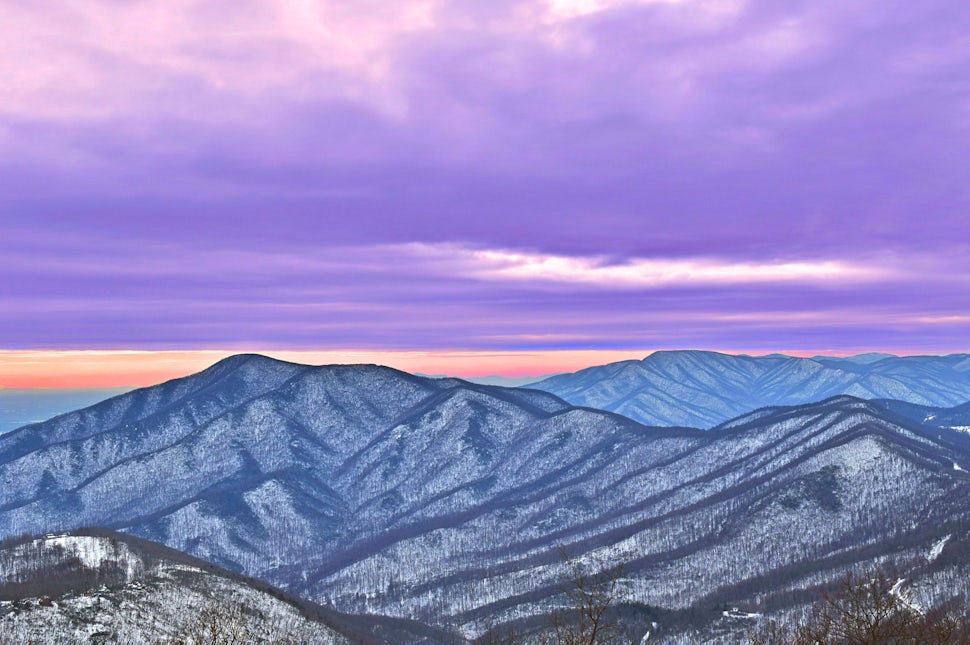The Art of Layering for Cold Weather Adventures
When it gets colder the layers get thicker.

I'm someone who loves adventuring out in the cold, but I don't like being cold. I’ve had my fair share of hikes where I’ve been caught in colder temperatures than I had anticipated and caught a chill. I’ve worn cotton under rain jackets (the worst) and made countless other layering mistakes. Over the years I’ve given my layering a little bit more effort, especially in the winter time. I LOVE a good, cold hike especially when the trails are abandoned, but nothing ruins a fun day outside more than catching a serious chill.
Before you start layering you should take a few things into consideration:
What are you doing? Will you be doing high-intensity activities like hiking or trail running or will you be doing lower intensity activity like skiing the green groomers at a resort? High intensity activities will cause you to sweat so you’ll need to make sure you’re wearing breathable, moisture-wicking base layers.
What’s the weather going to be like? If the temperatures are going to be low you’ll need to potentially choose a thicker base layer than normal. If the weather calls for snow, sleet or rain you may decide to bring a thicker outer shell jacket.
What are you like? You may be someone who is warm in the middle of a blizzard while others around you are freezing. Or you may be more like me where I always seem to be a little bit colder than everyone else. If you are always cold, choosing a thicker base layer will be more in your favor regardless off the activity.
Okay, now for the layers:
Start with your base layer. Your base layer should keep you dry and comfortable (wick moisture away from your body) and also help regulate your body temperature. While you may want to reach for a cozy cotton long sleeve tshirt, you should always skip cotton because cotton soaks up perspiration and can cause you to catch a chill. When selecting a base layer you should choose fabric that’s synthetic like polyester or merino wool. These fabrics wick moisture away from your skin to keep you dry. Depending on how cold it is where you live and your activity, you will need to carefully choose between a lightweight, midweight and heavyweight base layer. Lightweight is great if you’re going to be doing activities that get your heart rate high (running, hiking, etc.) and midweight is great if you’re going to be doing moderate levels of activity (slow paced hiking, mellow skiing, etc.). I’ve never used a heavyweight base layer but that would be for if you’re going to be in extremely cold, sub-zero temperatures or doing stationary activities in very cold temperatures. Personally, I always make sure my sports bra is made of synthetic material and I opt for a thinner long sleeve unless it’s going to be really cold and then I pick a midweight, thicker long sleeve.
The next layer you put on should be an insulating layer. This could be a down jacket, fleece jacket or thick wool sweater. Goose down is an incredible insulator however the second it gets wet it loses all its insulating capabilities while synthetic down can get wet and still insulate your body. If you wear goose down make sure you wear a very hardy waterproof shell over it (I’ll cover that in the next section). You can wear more than one mid-layer if you want! I usually like to wear two insulating layers during really cold days. This is personal preference! Whatever insulating layer you choose, make sure it isn’t too thick and can easily be layered.
Your final layer will be a jacket or “shell” that protects you from the elements. This layer is really important because it will keep you dry should inclement weather roll in. If you are wearing goose down, don’t ever go anywhere without a reliable, durable outer shell. As I mentioned before, once goose down gets wet it loses its ability to insulate your body. Another reason to wear a shell is to protect you from the wind. When the wind is whipping and makes its way through your insulating layer (if you’ve only worn a fleece and got caught in the wind you know what I’m talking about) it can chill your body temperature. If you find yourself in inclement weather, this layer will be one of the most important layers you area wearing!
Additionally I always wear, or at least bring, a pair of gloves and a neck warmer or hat! On my feet I wear a good, thick pair of merino wool socks and usually always wear waterproof hiking boots to keep my feet dry and warm even in the snow.
Some suggestions when it comes to layering:
- Try to keep your layers thin; you don’t want any one layer to be too thick. The idea is that you can quickly add or remove layers as needed.
- Always bring extra layers in the winter months.
- Remove layers during physical activity after your body warms up, while your base layer will wick away moisture you don’t want your other layers becoming saturated with perspiration.
What are your tips for layering?
We want to acknowledge and thank the past, present, and future generations of all Native Nations and Indigenous Peoples whose ancestral lands we travel, explore, and play on. Always practice Leave No Trace ethics on your adventures and follow local regulations. Please explore responsibly!
Do you love the outdoors?
Yep, us too. That's why we send you the best local adventures, stories, and expert advice, right to your inbox.










